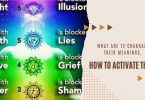I assume you are familiar with the fact that our energy constantly vibrates at a certain frequency. The only question is what exactly is the frequency that your energy vibrates at. Are we exposed to frequencies of hate or frequencies of love? Do we vibrate at a frequency of love or hate?
Frequency itself represents the value of vibration and oscillation measured during a certain period of time, usually during one second. A frequency simply represents a repeating sequence. Take the heartbeat for example, the average heart rhythm has a frequency of 60 to 100 beats per minute. Considering that 70% of our body is made up of water, it is logical to conclude that the sound that normally affects the crystals in the water also affects the water crystals in our body. Therefore, it also affects cells, chromosomes, and our DNA itself. The sound thus changes their structure, the only question is in what way.
Unfortunately, nowadays we are literally “buried” with bad sounds, bad frequencies. The most common frequencies to which our body is exposed are the frequencies of fear, apathy, anxiety, depression, sadness, anger.
These are the so-called emotions of low frequencies (20Hz to 150Hz), such frequencies weaken our body, in every sense. Mass media are to blame for “serving” such bad frequencies. So, for people who read the daily press and watch TV, especially reality shows, it can be concluded that their entire being, viewed from a holistic point of view, vibrates at a very bad frequency. A frequency that is highly susceptible to bacteria and viruses. Likewise, if a person surrounds himself with people who vibrate at a bad frequency, the outcome is the same ( please change the environment). Consequently, such people live shorter lives, for the simple reason that their entire being is literally suffocated by bad vibrations.
Each of our cells, tissues and organs has its own fundamental tone.
When, due to the influence of stress, pollution or heavy energies, cells and organs begin to vibrate at a different, lower frequency, there is a stoppage in the flow of energy, which manifests itself as tension, fear, depression, and illness. This fact is supported by a growing number of studies that indicate that sound can help reduce stress, induce deeper relaxation, and even healing.
It has been scientifically proven that the frequency of a healthy human body is from 62Hz to 68Hz. People whose body vibrates at this frequency or at higher frequencies do not suffer from anything. While on the other hand, for example, people whose body vibrates below 42Hz are people who have cancer, since the frequency of cancer starts below 42Hz. Today, measuring devices are available that can determine the frequency at which our body vibrates. Therefore, for people who do not read daily newspapers and do not watch TV, it can be safely said that they have decided to bring themselves to a better, more positive state of vibration. If you want the vibrations of love, joy, peace, compassion, or emotions of high frequencies (200Hz to 1000Hz) to flow through your body, one of the ways is to listen to the Schumann resonance. By listening to the Schumann resonance, in addition to strengthening our entire immune system, we bring our entire being into frequency harmony with planet Earth.
It is also recommended to listen to music at 432Hz (the frequency associated with the heart chakra) and 528Hz (this frequency repairs our DNA), these are the so-called love frequencies, as opposed to today’s music which is “tuned” to 440Hz, this frequency has been found to perform our body out of natural balance.
What is the best music for yoga?
When I think about it, there is no question whether you should listen to music during exercise, but what kind of music to listen to. Through music, we express both joy and sadness. One of the most common questions, when we meet someone, is about the kind of music we listen to. It further unites or separates us in our thoughts, habits, and attitudes.
Right now, I find the best music for yoga to be wordless, neutral, light and calming. I have noticed that practitioners like it least when there is no music during exercise. I still leave staying in silence for the beginning and end of yoga practice. Silence is priceless.
Sound can change our mood.
When it comes to the playlist for the yoga class, it mostly depends on the sensibility of the teacher himself. Even some yoga teachers have started playing pop and rock playlists during their classes. On one occasion, I attended a class where Metallica was also played, so anything is possible, you shouldn’t be overly surprised at anything.
As far as my current choice is concerned, it includes the repertoire of Deva Premal. There you can find tracks that are exclusively instrumental, but also a lot of tracks with vocals.
Also, I like to experiment with other genres of music that are not exclusively of the meditative type. More specifically, genres that are intended for spiritual disciplines.
Sometimes, I like to play a playlist that consists exclusively of liquid drum and bass tracks, mostly without vocals. Very often my playlist includes sounds from the Amazon. These are songs with or without words that are mainly performed in Amazonian indigenous tribes during various initiations. They are called Ikarus songs.
I found that I like to change my playlists according to the season. Accordingly, in the winter I mostly play instrumentals that are mostly of a very meditative nature. Spring when everything wakes up, that’s when I like to play tracks with vocals, that’s when Deva Premal is my first playlist choice. In the summer, I play rhythmic playlists. So, in the summer, the drum and bass playlist is an integral part of my music repertoire. When autumn arrives, I play Ikarus songs.
You should also keep in mind that the style of yoga can greatly influence the kind of playlist I will play. In any case, it is important to experiment with music. It may happen that a playlist that you thought was not at all your style suddenly turns on you.
Experiment with music. Explore different genres if you don’t have a favorite. Don’t stick to just one or two playlists. Just as everything in life is changeable, so it is in yoga.
Explore, listen, change. Enjoy your yoga practice with a melody that suits your sensibilities.
Namaste.







